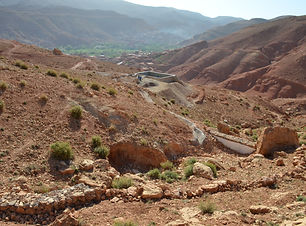GOALS :
Establish a diagnosis of the water path on his land.
Knowing how to adapt the different techniques to be implemented according to one's means.
Know how to make and use surveying tools.
Find out about the possible works to slow down, store and infiltrate runoff water.
Maintenance of paths, development against their degradation.
Discovery of agroforestry systems, to fight against soil erosion and desertification.
Training program
DAY 1 - Landscape reading tools
9h00 to 10h00: Evaluate the potential of a place and extract useful information
- Hygrometry, exceptional events (floods, storms, type of forest and trees, number of forest fires in the area over the last 50 years, annual rainfall and periods of rain, episodes of drought, etc ... (ex: mm of water that fell at one time, quantity and duration of the events).
10 a.m. to 11 a.m.: Observation of the landscape / Collecting information
- Extract essential information and put it on a map: Topography, terrace, area
erosion, bedrock, path, plant recognition, sources, soil structure,
prevailing wind, sunshine, stones for construction, search for water veins
underground, concave and convex areas, Keyline design, holistic management.
11h00 to 12h30: Organization of logistics and development works
- Anti-erosion techniques: Keyline design, swales, boomerang, zaï, arboriculture on
level line, earthworks, planting of vegetation and plant cover, assembly of
stones of the Hopi Indians.
All of these techniques are intended to slow down and help water to infiltrate.
2:30 p.m. to 5:00 p.m .: Landscape observation, information gathering, zoning and picketing
3 one-hour workshops / 3 groups (≈10). Each group participates in the 3 workshops and will have a roadmap to guide the information gathering.
- Topography: take the level lines and mark the points:
3 pers. with an Egyptian compass, 4 pers. at the water level and 3 pers. at laser level.
- Zoning: general information gathering, walk, observation of the land, position on the
plan, the paths of the water, find the traces and lines of erosion, note them in order
of importance (small, medium, large).
- Vegetation: wooded areas, covered shaded, humid, full sun, etc. Evaluation
m² of each area, search for available raw materials (stone, dead wood, etc.), recognition of plants, herbarium in the area.
5:00 p.m. to 6:00 p.m .: End of the day
- Debriefing, exchange .
DAY 2 - Design of the area
8:30 am to 9:00 am:
- Explanation and organization of each group.
9h00 to 10h00:
- Adapt the anti-erosion structures to its terrain, evaluation of their size and number
of works to be installed.
- Estimation of works by structure.
- Role of plants: settlements, what types? Why ? How? 'Or' What ?
10:00 am to 12:30 pm:
- Circulation of underground water veins, concave and convex areas, Keyline concepts
Design (Darren Doherty) and holistic management (Allan Savary).
2:30 p.m. to 5:00 p.m .: Group work
- Preparation of anti-erosion plant barriers on the level line.
- Introduction to geobiology, search for water veins with dowsing rods.
5:00 p.m. to 6:00 p.m .: End of the day
- Debriefing, exchange.
DAY 3 - Organization of zoning
9h00 to 11h00: Practical work
- Plan the areas of the land.
11h00 to 12h30: Practical work
- Picketing: Stake out the level line of the areas to be developed, find the resource places
(stone, sand, clay).
2:30 p.m. to 3:00 p.m .: Practical work
- Picketing (continued): Stake out the level line of the areas to be developed, find the places
resources (stone, sand, clay).
3:00 p.m. to 5:00 p.m .: Practical work
- Mark the water lines, the thalwegs, assess their size, define the materials, time,
human resources required.
5:00 p.m. to 6:00 p.m .: End of the day
- Debriefing, exchange.
DAY 4 - Establishment of plant corridors
9 a.m. to 10 a.m.
- Position on the plan the possible structures to be put in place.
- Choice of techniques according to the materials on site and the size of the works to be
implement.
10:00 a.m. to 12:30 p.m.
- Trace arboreal corridors, prepare the list of species (upstream), prepare the holes,
compost, tools, green manure seeds (tractor with chisel, cover crop as well
that a backhoe loader may be necessary depending on the size of the structures to be developed).
2:30 p.m. to 5:00 p.m .: Group work
- Prepare tools, transport materials, calibrate stones.
- Tree planting and green manure sowing (tractor with chisel, cover crop as well as a
backhoe loader may be necessary depending on the size of the structures to be developed).
5:00 p.m. to 6:00 p.m .: End of the day
- Debriefing, exchange.
DAY 5 - Launch of anti-erosion structures
9:00 a.m. to 11:00 a.m.
- Gather materials on site.
11:00 a.m. to 11:30 a.m.
- Distribution of teams.
11:30 a.m. to 12:30 p.m.
- Start of work.
2:30 p.m. to 5:00 p.m.
- Rotation of work teams.
5:00 p.m. to 6:00 p.m .: End of the day
- Assessment of training, exchanges.
.png)
